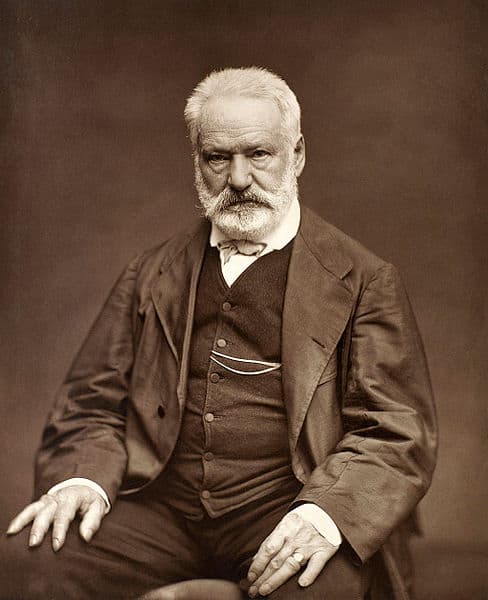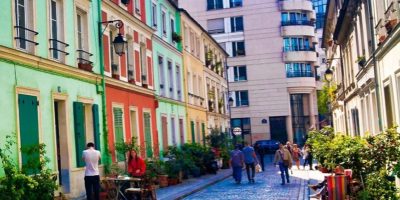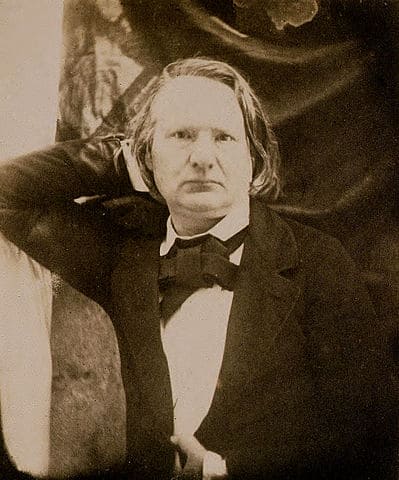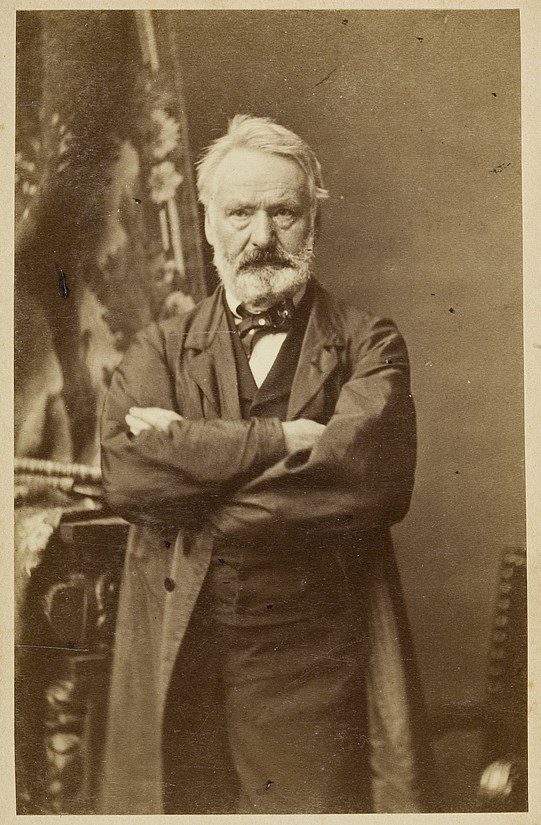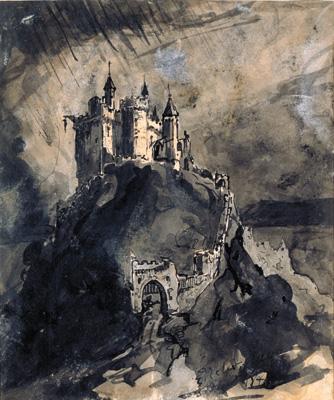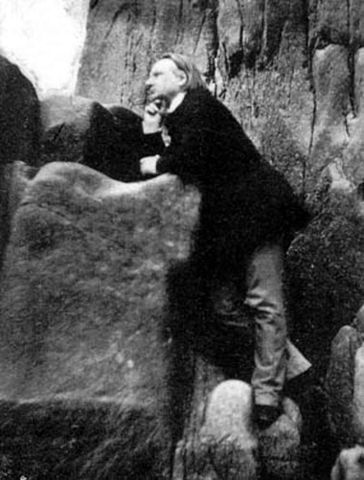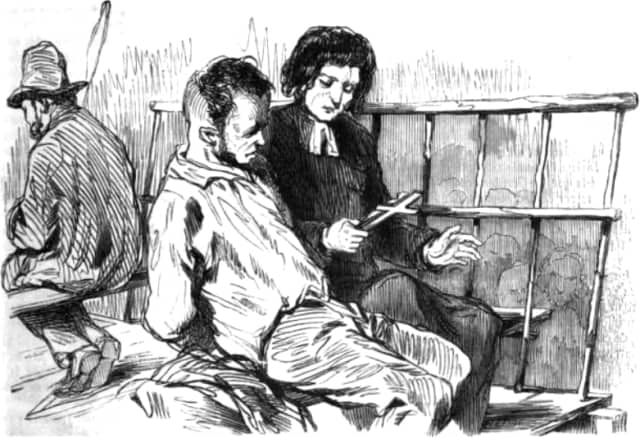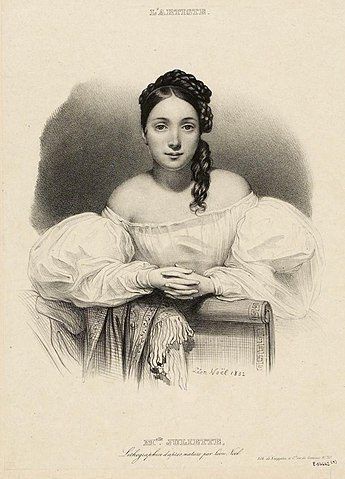Top 15 interesting facts about Victor Hugo
*Originally published by Molli on November 2019 and Updated by Vanessa R in April 2023
Victor Hugo just may be the most famous French writer in history! His stories have been reproduced into plays, musicals and feature-length films, and he has become a household name.
He was also involved in politics and he fought against social injustice. He helped to save the Notre-Dame Cathedral, and he was a talented artist as well! He lived a full and interesting life, and his works continue to be studied all over the world.
Do you want to learn more about this French author? Keep reading to discover my top 15 interesting facts about Victor Hugo!
1. Victor Hugo is a celebrated French writer
Victor Hugo had many talents, but he was first and foremost a successful novelist, poet and playwright.
Hugo was born in eastern France in 1802. His father once told him that he was conceived in a mountain range at very high elevation. His father credited his genius with the fact that he was, er, created at such a high altitude. If we consider Hugo’s success, his father may have been right!
Hugo completed his first novel, Han d’Islande (Hans of Iceland in English) when he was 21 years old, in 1823. His second, Bug-Jargal was completed 3 years later. Hugo was hugely influenced by the Romantic writer François-René de Chateaubriand, but Hugo contributed much to the Romanic literary movement himself.
Hugo published poetry (more on that later on) and plays as well. His play Cromwell, is thought to contain the Romantic manifesto in it’s prologue. His play Hernani was released and performed at the Comédie-Française in 1830, and marked the beginning of romanticism in France!
You probably know Hugo’s name thanks to his later works, Notre-Dame de Paris and Les Misérables. Let’s learn more!
2. Notre-Dame de Paris and Les Misérables are Victor Hugo’s most famous works
Notre-Dame de Paris (The Hunchback of Notre-Dame in English) was published in 1830, and was swiftly translated into many other languages. The story is set in 15th century Paris, and tells the tale of Quasimodo and Esmeralda.
But, for Hugo the Notre-Dame Cathedral was the most important character in the book. He was actually disheartened that the title of the book was translated to The Hunchback of Notre-Dame in English! I’ll be giving you some more details on this masterpiece that coming up!
Les Misérables was published in 1862, but Hugo began writing it almost immediately after her finished The Hunchback of Notre-Dame. The novel takes place in the early 19th century, and it touches on social injustice and the difficulties of the poor in Paris at the time. As he was working on the book, Hugo had the presentiment that it was going to be huge. And it was! The issues brought up by the novel were even discussed at the National Assembly of France after it’s publication.
3. Victor Hugo wrote the Notre-Dame de Paris in an attempt to save the cathedral
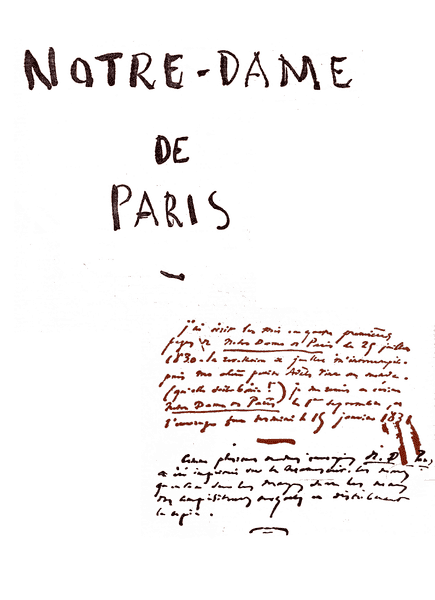
First page of the manuscript of Notre-Dame de Paris by Victor Hugo. Copy from Encyclopédie Autodidactique Quillet, Tome 3, 1960. Original in the Bibliothèque Nationale – WikiCommons
The goal behind the publication of The Hunchback of Notre-Dame was ultimately to raise awareness of the decrepit state of the massive cathedral in Paris. Hugo also wanted to point out the importance of Gothic architecture in general.
At the time of writing, the Notre-Dame Cathedral had fallen into disrepair. The beautiful stained glass windows that we can see today were taken out and replaced by white glass in order to bring more light into the cathedral, and the rest of the cathedral was in desperate need of some TLC.
You’ll notice that the book contains long descriptions of the cathedral itself, which called on Parisians to recognize the beauty of its medieval design. Hugo was on a mission to save the medieval architecture in Paris!
His plan worked. The book was extremely popular, and lanced a period of Gothic revival architecture across France and Europe. It led to major renovations and restorations on the Notre-Dame Cathedral, which were led by the famous architect Eugène Viollet-le-Duc. We can thank Mr. Hugo for the way that the cathedral looks today!
4. Les Misérables by Victor Hugo is one of the longest novels in history

Young Cosette sweeping: 1886 engraving for Victor Hugo’s Les Misérables by Émile Bayard – WikiCommons
Les Misérables tells the story of many different characters, notably the protagonist Jean Valjean. The story spans over 17 years, beginning in 1815, and ending in 1832. Hugo spent over 15 years writing Les Misérables.
The novel contains 5 volumes, with a whopping 365 chapters and 1,400 pages long (in the original French there are 1,900 pages). It is considered to be one of the longest novels in history!
The release of the book was very much anticipated, and was met with mixed reviews. Many famous authors, such as Gustave Flaubert and Charles Baudelaire, did not like the novel at all and gave harsh reviews.
Many did not like the way that the revolutionaries were portrayed, and felt that it encouraged riots and revolutions. The book was even banned by the Catholic Church! The book was translated into many different languages, and although it received a lukewarm reception in France, it was well-loved elsewhere.
5. Victor Hugo was also a poet
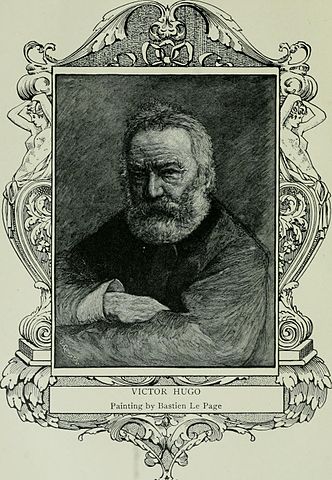
Illustration of Victor Hugo in the book, The history and progress of the world by Edgar Sanderson, John Porter Lamberton and Charles Morris, 1913 – WikiCommons
In addition to writing plays and novels, Hugo was also a poet. After he published his first 2 novels, he began to dedicate himself to poems. Between 1829 and 1840, he released 5 volumes of poetry.
His first collection of poems was published when he was just 20 years old in 1822, and is called Odes et poésies diverses (Odes and various poems in English). The French king at the time, Louis XVIII liked his work so much that he granted Hugo a royal pension.
This was just the beginning of Hugo’s career as a poet, as in 1826 he published another volume called Odes et Ballades (Odes and Ballads in English), that was warmly received by the public.
My favorite poem from Hugo came in his later years, and is dedicated to his eldest daughter Léopoldine. It is called Demain dès l’aube (Tomorrow, at dawn in English) and describes a visit to her grave. I definitely recommend you look it up and read it! I’ll be filing you in on her death later on in this article.
6. Victor Hugo was also a talented artist
Just when you thought that Hugo couldn’t get any more talented. He was also an illustrator! Over the course of his lifetime, he produced more than 4,000 drawings. Hugo kept these drawings to himself, as he didn’t want them to take his writing out of the spotlight.
Hugo’s drawings were all relatively small, and were typically done in black and white. He only really shared them with his family and friends. His works can be described as abstract, and were shockingly modern for the period. Although the Surrealist movement didn’t appear until much later, Hugo appeared to be ahead of his time.
Hugo got really into drawing when he was exiled!
7. Victor Hugo spent 15 years in exile
In 1841, Hugo was elected to the Académie Française, a French council that holds authority over the French language and all matters concerning it. Hugo had been trying to be elected for years, but other members tried to keep him out as they were against the Romantic movement that Hugo was a part of.
Hugo soon became deeply involved in French politics. He fought for social reform, and shed light on the miserable conditions of the poor in France. He was even elected to the National Assembly, and made speeches against the death penalty and social injustice. He also advocated for free education.
In 1851, Napoléon III came to power and called for an anti-parliamentary constitution. Hugo was furious, and publicly denounced the new leader as a traitor to France. He subsequently fled to Brussels, and then onto Guernsey, an English island off the coast of Normandy.
Hugo lived in exile from 1855 until 1870. While he was exiled, he published pamphlets and completed and published Les Misérables. Not to mention his drawings!
8. Victor Hugo fought against the death penalty
I’ve already briefly mentioned that Hugo became involved in politics in the mid-19th century. He was really passionate about improving conditions for the poor, and eradicating the death penalty. He believed that no matter the situation, it was cruel and barbaric.
When Hugo was elected to the National Assembly, most of his speeches called for the elimination of capital punishment. He also published a short novel called Le Dernier Jour d’un Condamné (The Last Day of a Condemned Man in English), which described the thoughts of a man that was condemned to death by the guillotine.
Hugo had witnessed several people killed by guillotine and found the process crude and uncivilized. The novel is heartbreaking to read, and really raised awareness of the brutality of the death penalty.
Hugo’s work in France has been credited with prompting countries like Portugal, Colombia and Geneva to get rid of the death penalty. His fame had a very strong international influence!
9. Victor Hugo found out about his daughter’s death from a newspaper
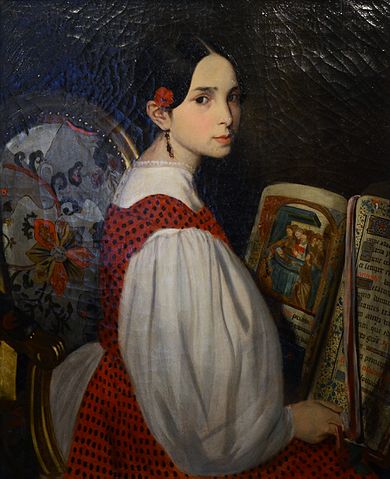
Portrait of Léopoldine Hugo, as seen in Victor Hugo’s home in Paris by Auguste de Châtillon – WikiCommons
Hugo was married to a woman named Adèle Foucher in 1822. Foucher was Hugo’s childhood friend, and they were engaged in secret because Hugo’s mother didn’t like her. Foucher and Hugo didn’t officially marry until after the death of Hugo’s mother.
The couple had 5 children together. Their first born, a son named Leopold, died as an infant, and was followed by the birth of Léopoldine, Charles, François-Victor, and Adèle. His eldest daughter, Léopoldine is considered to be his favorite.
Tragedy struck in 1843, when Léopoldine drowned at the age of 19. She was on a boat with her husband when the ship capsized. The weight of her heavy skirts pulled her down to her death. Her husband also died, trying to save his young wife’s life.
Hugo was traveling in the South of France when he learned of the news from a newspaper that he picked up in a café. The news was devastating, of course, and changed Hugo indefinitely. I already mentioned the poem that the author wrote about her, which I recommend you read!
10. Victor Hugo was a womanizer his entire life
Although Hugo was married with children, he had many mistresses throughout his life. In addition, his wife also carried out extramarital affairs. Despite this, the pair lived together for almost 50 years before Foucher’s death in 1868.
Hugo had many casual relationships, but there are at least 2 mistresses that are worth mentioning. The first, Juliette Drouet, was completely obsessed with Hugo and even went into exile with him. Hugo went so far as to call her his “widow” in 1870. Strangely, even after the death of his wife, Hugo never officially married Drouet.
Léonie d’Aunet was another important mistress for Hugo. She was also married, and the couple was caught in the act in 1845. Hugo escaped the situation unscathed, but d’Aunet was sentenced to 2 months in prison, and another 6 months at a convent. The laws of the day! *insert eye roll here*
Since he was a writer, Hugo recorded all of his affairs and sexual relationships in code in his diary. He was involved with servants, maids, actresses, prostitutes and even revolutionaries like the famous Louise Michel.
Hugo died at the age of 83 in Paris, and it is said that he continued to be sexually active, even in his old age.
11. Victor wrote while naked to avoid writer’s block
Even though Victor Hugo was considered a genius, he occasionally experienced writer’s block. Hugo didn’t have the best attention span, so to conquer this he had to come up with a solution. He would request to be stripped off and left in a room to write in order to get rid of writer’s block. Victor Hugo would only be allowed to get his clothes back once he had finished writing for the day.
12. He was one of the world’s most highly paid authors
Victor Hugo was never poor, despite the fact that he wrote about the underprivileged and disadvantaged. Hugo actually wanted to be paid more than any other person has ever had to write a book since he was so sure of his value as a writer and said as much while negotiating the sale of Les Misérables with his publisher. The biggest payment ever for a piece of literature is said to have been 300,000 francs (about £3 million now), according to rumours.
13. He had dinner parties where he would list to his guests why he was superior to other French authors
Being that the street he resided on was named after him while he was still alive, Victor Hugo was by no means a humble author, I mean would you be humble if you had a street named after you? Hugo would often spend dinner parties explaining to his guests why he was better than every other French author, and fans would often take pebbles he stepped on as souvenirs, he was basically an idol. It’s an understatement to say that Victor Hugo bought into his own hype.
14. He’d pop an entire orange in his mouth in front of his guests
Victor Hugo enjoyed entertaining more than anything else, and he regularly had dinner parties with up to 30 guests. During these rowdy get-togethers, Hugo liked to perform a really amusing party trick: he would pop an entire orange in his mouth, stuff his cheeks with as many sugar lumps as he could, churn it all up, and then swallow it down with the help of two glasses of kirsch.
15. Victor’s dad always believed his son would have an interesting life
His father loved to tell Victor Hugo that his conception signified a life that would be quite special. Leopold and Sophie were 3000 feet above sea level when he was born in May 1801, and Victor went on to live the extraordinary life predicted by his father. Victor Hugo was conceived exactly where a stone plaque now stands and bears the inscription: IN THIS PLACE / ON 5 FLOREAL, YEAR 9 / VICTOR HUGO / WAS CONCEIVED.
Conclusion
There you have it, my dear readers, my top 10 favorite interesting facts on Victor Hugo! He contributed much to the world of literature and politics, and his legacy continues to live on today.
If you’ve never read any of his work, there are a ton of options mapped out for you above. Head to your local bookstore and get started!
To learn more about Paris and French celebrities like Victor Hugo, why not join one of our walking tours? Click here to discover the different options and to make your booking!
Planning a trip to Paris ? Get ready !
These are Amazon’s best-selling travel products that you may need for coming to Paris.
Bookstore
- The best travel book : Rick Steves – Paris 2023 – Learn more here
- Fodor’s Paris 2024 – Learn more here
Travel Gear
- Venture Pal Lightweight Backpack – Learn more here
- Samsonite Winfield 2 28″ Luggage – Learn more here
- Swig Savvy’s Stainless Steel Insulated Water Bottle – Learn more here
Check Amazon’s best-seller list for the most popular travel accessories. We sometimes read this list just to find out what new travel products people are buying.

